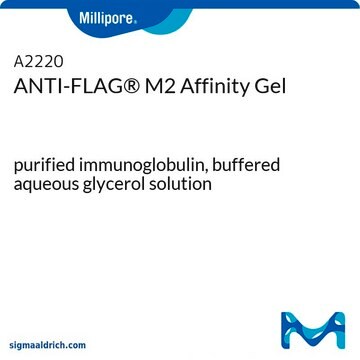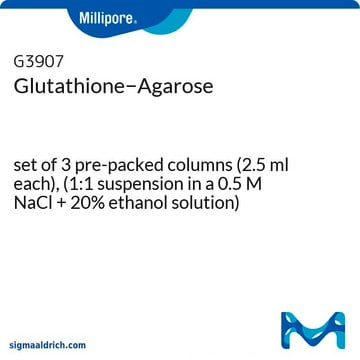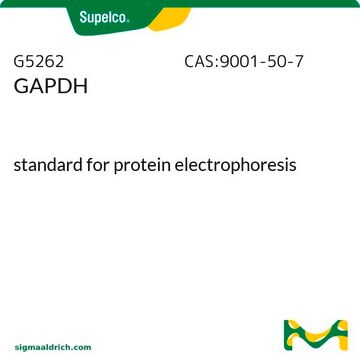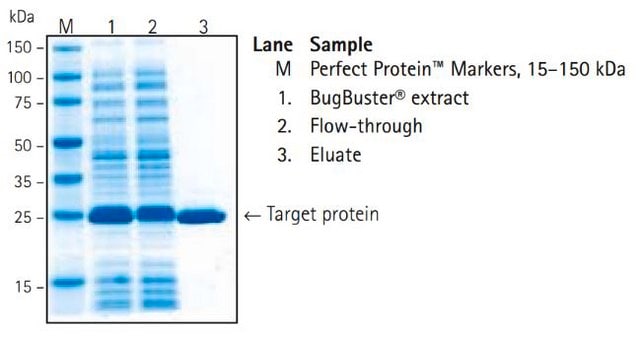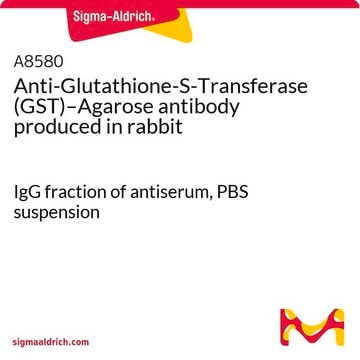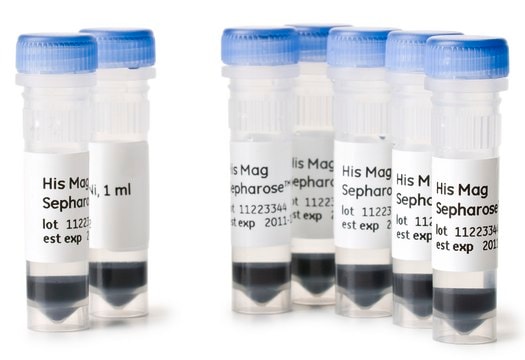G0924
Glutathione High Capacity Magnetic Agarose Beads
(1:1 suspension in a 30% ethanol solution)
Sinonimo/i:
Magnetic agarose beads
Scegli un formato
CHF 101.00
Scegli un formato
About This Item
CHF 101.00
Prodotti consigliati
Coniugato
magnetic beads
Livello qualitativo
Stato
(1:1 suspension in a 30% ethanol solution)
Classi chimiche degli analiti
proteins (GST)
tecniche
immunoprecipitation (IP): suitable
protein purification: suitable
Matrice
4% beaded magnetic agarose
Braccio spaziatore
12 atoms
Capacità
≥15 μmol/mL, agarose binding capacity
Condizioni di spedizione
wet ice
Temperatura di conservazione
2-8°C
Cerchi prodotti simili? Visita Guida al confronto tra prodotti
Descrizione generale
The Glutathione Magnetic Agarose Beads are useful for affinity capture, molecular pull-down, or immunoprecipitation (IP) of proteins containing glutathione binding sequences, such as native glutathione S-transferase (GST), glutathione peroxidase, and glyoxalase I, or GST-tagged recombinant fusion proteins from cell lysates or other biochemical solutions while exhibiting low non-specific binding of other proteins. Recombinant GST-tagged proteins, bound to the affinity resin are separated with the use of a magnet. The magnetic properties allow for very rapid processing, as well as aid in manipulations, such as repetitive washings and recovery of the desired protein. This leads to faster recovery, experimental reproducibility, and more accurate quantitation of the proteins of interest.
The matrix of the magnetic beads is a 4% beaded agarose with an average diameter of 50 μ and a diameter range of 20-75 μ. Paramagnetic iron is impregnated within the beads.
Applicazioni
Stato fisico
Avvertenze
Danger
Indicazioni di pericolo
Consigli di prudenza
Classi di pericolo
Flam. Liq. 2
Codice della classe di stoccaggio
3 - Flammable liquids
Classe di pericolosità dell'acqua (WGK)
WGK 2
Scegli una delle versioni più recenti:
Certificati d'analisi (COA)
Non trovi la versione di tuo interesse?
Se hai bisogno di una versione specifica, puoi cercare il certificato tramite il numero di lotto.
Possiedi già questo prodotto?
I documenti relativi ai prodotti acquistati recentemente sono disponibili nell’Archivio dei documenti.
I clienti hanno visto anche
Contenuto correlato
Per studiare in vitro le interazioni proteina-proteina potete ricorrere a saggi di pull-down per affinità, o GST pull-down, purificazione per affinità in tandem (TAP) e co-immunoprecipitazione.
Investigate in vitro protein-protein interactions with pull-down assays, utilizing affinity, GST pull-down, TAP, and co-immunoprecipitation methods.
Active Filters
Il team dei nostri ricercatori vanta grande esperienza in tutte le aree della ricerca quali Life Science, scienza dei materiali, sintesi chimica, cromatografia, discipline analitiche, ecc..
Contatta l'Assistenza Tecnica.




